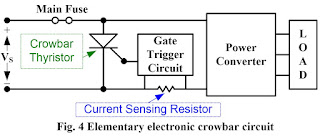Protection of Power Semiconductor Devices
Reliable operation of a thyristor demands that its specified ratings are not exceeded. There are two types of protection required:
- di/di Protection
- If the rate of rise of anode current, i.e. di/dt is large as compared to the spread velocity of carriers, local hot spots will be formed near the gate connection. This localized heating my destroy the thyristor.
- The value of di/dt can be maintained below acceptable limit by using a small inductor, called di/dt inductor in series with the anode circuit.
- Typical di/dt limit value of SCRs are 20-500 A/μ-sec.
- dv/dt Proctection
- If the rate of rise of suddenly applied voltage across thyristor is high, the device may get turned on. It leads to false operation of the thyristor circuits.
- Typical values of dv/dt are 20-500 V/μ-sec.
- False turn-on of a thyristor by large dv/dt can be prevented by using a snubber circuit in parallel with the device.
Design of Snubber Circuits
- When switch S is closed, a sudden voltage appears across the circuit as given in Fig. 1. Capacitor Cs behaves like a short circuit, Therefore voltage across SCR is zero.
- With the passage of time, Voltage across Cs builds up at a slow rate such that dv/dt across Cs and therefore across SCR is less than the specified maximum dv/dt rating.
- Before SCR is fired by gate pulse, Cs charges to full voltage Vs. When the SCR is turned ON, capacitor discharges through the SCR and sends a current equal to Vs/(Resistance of local path forward by Cs and SCR).
- In order to limit the magnitude of discharge current ID, a resistance Rs is inserted in series with Cs.
- In actual practice, Rs, Cs, and the load circuit parameters should be such that dv/dt across Cs during its charging is less than the specified dv/dt rating of the SCR, and discharge current at the turn ON of SCR is within reasonable limits.
Over-voltage Protection
Transient over-voltages causes either maloperation of the circuit by unwanted turn-ON of a thyristor or permanent damage to the device due to reverse breakdown. A thyristor may be subjected to internal or external over-voltages.
- Large voltages may be generated internally during the commutation of a thyristor. External over-voltages are caused due to the interruption of current flow in an inductive circuit and also due to lightening strokes on the lines feeding the thyristor system.
- Suppression of over-voltages: Thyristors are chosen with their peak voltage ratings of 2.5 to 3 times their normal peak working voltage.
- The effect of over-voltages is usually minimized by using RC circuits and non-linear resistors called voltage clamping device.
- RC snubber is not enough for over-voltage protection of SCR, therefore a combined protection consisting of RC snubber and VC device is provided to thyristor.
- The VC device has falling resistance characteristics with increasing voltage. a) Under normal working conditions of voltage below the clamping level: The device has a high resistance and draws only a small leakage current. b) When a voltage surge appears: The varistor device operates in the low resistance region and produces a virtual short circuit across the SCR.
- Selenium thyrector diodes, metal oxide varistors or avalnche diodes suppressors are commonly employed for protecting the thyristor circuit against over-voltages.
Over-current Protection
Thyristors have small thermal time constants. Therefore, if a thyristor is subjected to over-current due to faults, short circuits or surge currents, it junction temperature may exceed the rated value and the device may be damaged.
- Over-current protection is achieved by the use of circuit breakers (CB) and fast acting fuse. A circuit breaker has long tripping time, Therefore generally it is used against surge currents of long duration. A fast acting current limiting fuse (FACLF) is used against a large surge currents of very short duration.
- The tripping time of CB and the fusing time of FACLF must be properly coordinated with the rating of thyristor.
Gate Protection
Over-voltages across the gate circuit can cause false triggering of the SCR, while Over-current may raise junction temperature beyond specified limit leading to its damage.
- Protection against over-voltages is achieved by connecting a zener diode (ZD) across the gate circuit as given in Fig. 3. A resistor R2 connected in series with the gate circuit provides protection against over-currents.
- Protection against undesirable firing is obtained by using shielded cables or twisted gate leads.
- A capacitor and a resistor are also connected across gate to cathode to bypass the noise signals. (C<0.1μF)
Reference
- M. H. Rashid, “Power Electronics: Circuits, Devices and Applications,” Prentice Hall India, Second Edition, 2006.
- P. S. Bimbhra, "Power Electronics," Khanna Publishers, fifth edition, 2012.









Post a Comment